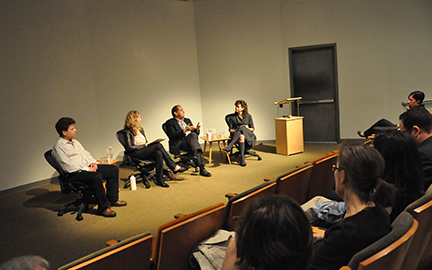
7 Tips for Leading Clients Towards Greener Design Solutions
As a business owner I learned long ago that designing great projects is one thing, but leading a client towards entrusting you with their brand is an incredibly crucial —and often overlooked — part of the process.
Recently I organized a panel discussion for Spark Design Professionals and AIGA/NY to explore how during initial business conversations some of New York City’s top green designers are able to shape projects into environmentally friendly communications. I wanted to glean an inside perspective on what these successful advocates did to shift the conversation beyond simple aesthetics and dig deeper into the purpose of the promotion, the materials, and manufacturing process used.
During the panel, I spoke with Don Carli, a Senior Research Fellow with the nonprofit Institute for Sustainable Communication (ISC). The Institute’s mission is to foster the widespread adoption of economically viable, effective, and environmentally-friendly uses of print and digital media. I also spoke with Cheryl Heller, CEO of Heller Communication Design, who believes that communication design has a vital role to play in the creation of a sustainable future, and Hugh Hough a global warming ambassador for Al Gore’s The Climate Project. In 1993 Hugh founded Green Team, New York’s first (and only) environmental advertising agency.
What I’ve learned during our conversations is that there’s no such thing as a one-step to “sustainable” process. When seeking to help a client go green, it’s best to acknowledge that 100% sustainable is really still an aspiration. Many of processes and systems inside and outside of the design industry simply aren’t there yet. However, rather than this becoming a deterrent from getting started, this should be seen as an invitation to become an industry leader. Small moves really add up and any effort can make a difference.
Here are 7 things I took away from our conversation:
- Buck the false sentiment that clients and consumers have to choose between cost savings and eco-friendly. Green efforts don’t need to cost more. In fact, they often can actually save a company money by reducing waste, shipping costs, and unnecessary expenditures.
- The language of business is the language of risk. When you identify for a client the costs of not greening their materials, product offering, and/or systems, you are actually bringing greater value to the work that you do. This is a great tip any designer can use beyond the green conversation.
- One of those risks is customer scrutiny and backlash. Social media has empowered consumers to speak their minds. Be sure to make claims that are truthful and accurate. No need to claim that your client is the greenest, highlighting specifically what you are doing is green is enough. Also be sure to check your entire supply chain so that you are fully aware of what is green and not-so-green behind the scenes.
- It’s important to consider the entire system of communication materials and really understand why the piece you are creating is necessary. Cheryl Heller mentioned that her firm has decided to stop making stuff and focus primarily on creating communication system plans for clients.
- With any promotion, the media you are using — the ink, to the paper, plastic components, printer, production process, or the digital media should also be discussed. Don Carli has recently come across some research that challenges the notion that digital media is inherently more eco-friendly that print. Don points out that the electricity required to power the servers, computers and technology used for digital media must come from somewhere and currently much of that is coal powered. Research shows that, we are currently consuming more electricity through our use of digital media than ever before.
- Besides the economical and business benefits of going green there is also the emotional value green design brings. When reviewing several product offerings that are considered equal, consumers generally want to do the right thing. Mintel released a report last month that 35% of consumers are willing to pay more for green products. And while not everyone’s sole concern is the environment, providing end-benefits to consumers such as health benefits has been shown to consistently increase brand value.
- When dealing with a client who has an ordinary product offering and isn’t thinking of “going green,” it’s important to reach the client in a place that they understand. Hugh Hough suggests that you have to give every client your best work, answering their business objectives first. Then along the way be sure to point out that extra special thing they think is so cool, just so happens to be green.


